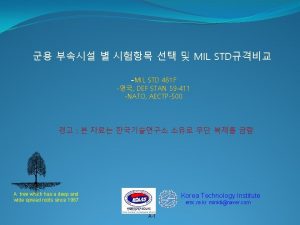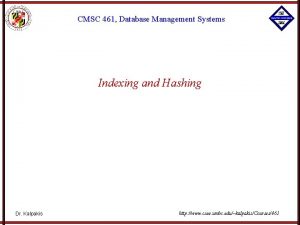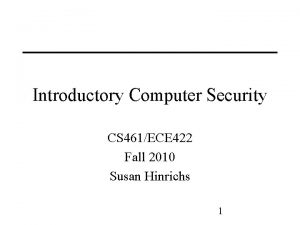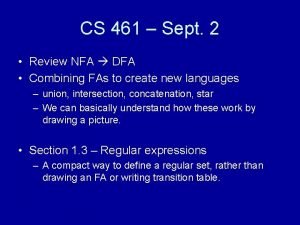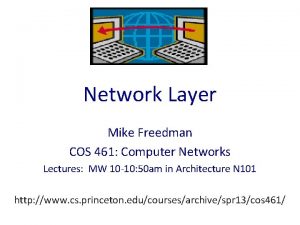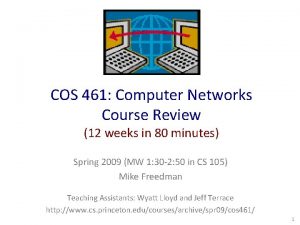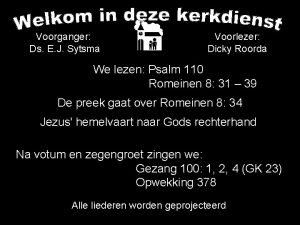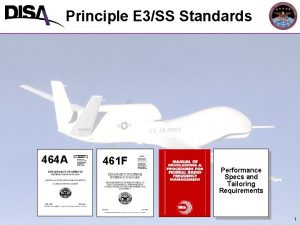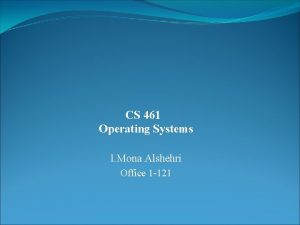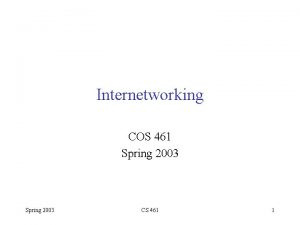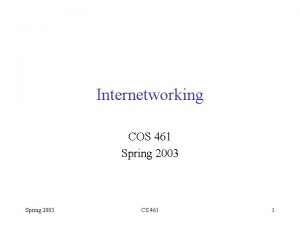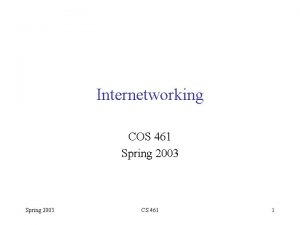CS 461 Operating Systems I Mona Alshehri Office












- Slides: 12

CS 461 Operating Systems I. Mona Alshehri Office 1 -121

A UNIX operating system consists of a : kernel and some system programs. There also some application programs for doing work.

Kernel : • The kernel is the heart of the operating system. • It keeps track of files on the disk, starts programs and runs them concurrently, assigns memory and other resources to various processes, receives packets from and sends packets to the network, and so on. • The kernel does very little by itself, but it provides tools with which all services can be built. It also prevents anyone from accessing the hardware directly, forcing everyone to use the tools it provides. This way the kernel provides some protection for users from each other. The tools provided by the kernel are used via system calls.

System Programs: The system programs use the tools provided by the kernel to implement the various services required from an operating system.

System Programs: • The difference between system and application programs is one of intent: applications are intended for getting useful things done (or for playing, if it happens to be a game), whereas system programs are needed to get the system working. A word processor is an application; mount is a system program. • In order to access any file system, it is first necessary to mount it. By mounting a file system, you direct Linux to make a specific device (and partition) available to the system. • An operating system can also contain compilers and their corresponding libraries (GCC and the C library in particular under Linux), although not all programming languages need be part of the operating system. Documentation, and sometimes even games, can also be part of it.

The Shell : • Whenever you login to a Linux system you are placed in a program called the shell. You can see its prompt at the bottom left of your screen. To get your work done, you enter commands at this prompt. • The shell acts as a command interpreter; it takes each command passes it to the operating system kernel to be acted upon. It then displays the results of this operation on your screen. ﺍﻟﺘﻲ ﺗﻔﺴﺮ ﻭﺗﻨﻔﺬ ﺍﻻﻭﺍﻣﺮ user interface • ﻫﻲ ﻭﺍﺟﻬﺔ ﺍﻟﻤﺴﺘﺨﺪﻡ ﻟﻴﻨﻜﺲ ﺷﻞ. ﺍﻭ ﺍﻟﻨﻮﺍﺓ kernel ﻭﺗﺤﻠﻠﻬﺎ ﺍﻟﻰ command prompt ﻳﻘﺎﺑﻞ ﺍﻟﺪﻭﺱ ﻓﻲ ﺍﻟﻮﻳﻨﺪﻭﺯ

Important parts of the Kernel The Linux kernel consists of several important parts: process management, memory management, hardware device drivers, filesystem drivers, network management, and various other bits and pieces. Figure shows some of them

Important parts of the Kernel • Probably the most important parts of the kernel are memory management and process management. • Memory management takes care of assigning memory areas and swap space areas to processes, parts of the kernel, and for the buffer cache. • Process management creates processes, and implements multitasking by switching the active process on the processor.

Major services in a UNIX system Init: is started as the first process of every Linux system, as the last thing the kernel does when it boots. When init starts, it continues the boot process by doing various startup chores (checking and mounting filesystems, starting daemons, etc).

Daemons: ﺑﺘﺸﻐﻴﻞ ﺑﻌﺾ ﺍﻟﺒﺮﺍﻣﺞ ﻓﻲ ﺍﻟﺨﻠﻔﻴﺔ ﺩﻭﻥ ﺗﺪﺧﻞ ﻣﻦ kernel ﻳﻘﻮﻡ ﺍﻝ ﻭ ﻫﻲ ﺗﻨﻔﺬ ﻣﻬﺎﻡ Daemons ﺍﻟﻤﺴﺘﺨﺪﻡ ﻭ ﻳﻄﻠﻖ ﻋﻠﻰ ﻫﺬﻩ ﺍﻟﺒﺮﺍﻣﺞ ﺍﺳﻢ . ﺗﺘﻌﻠﻖ ﺑﺎﻟﻨﻈﺎﻡ process execute in background(run quietly without user interaction ) perform critical services, e. g. , respond to incoming network packets. name usually ends in ‘d’ examples: syslogd, crond, lpd

C Programming The following program reads two numbers and finds the sum of those two numbers: #include <stdio. h> #include <conio. h> Void main () { int a, b, x; printf ("Enter the values for integers a and bn") ; scanf ("%d %d", &a, &b); x=a+b; printf ("The result is = %dn", x) ; getch(); }

C Programming Pointers in C #include <stdio. h> #include <conio. h> void main() { int a; int* p; printf("enter number a: "); scanf("%d", &a); p=&a; printf("The value of a: %dn", a); printf("The address of a: %xn", &a); printf("The value of p: %xn", p); printf("The value of *p: %dn", *p); printf("The Address of p: %xn", &p); getch(); }

